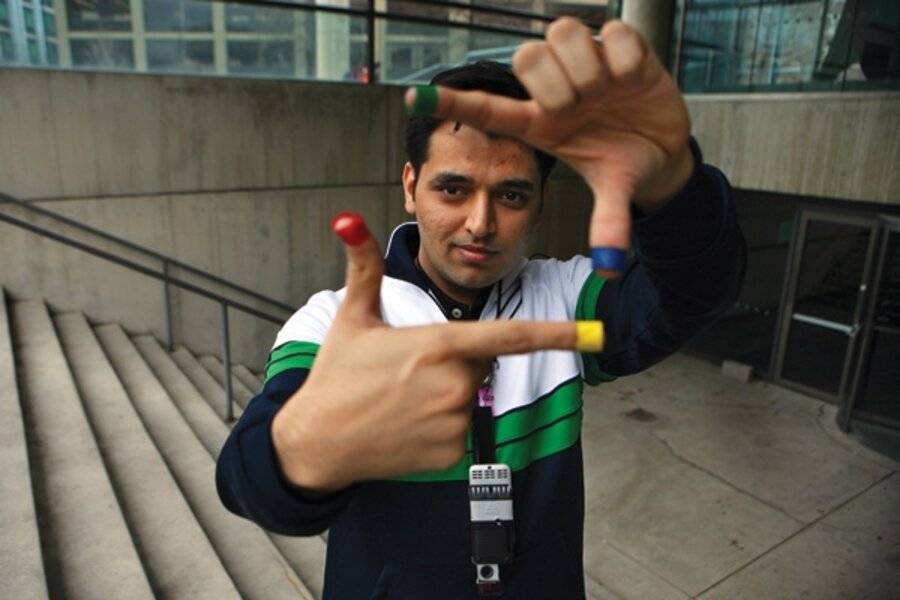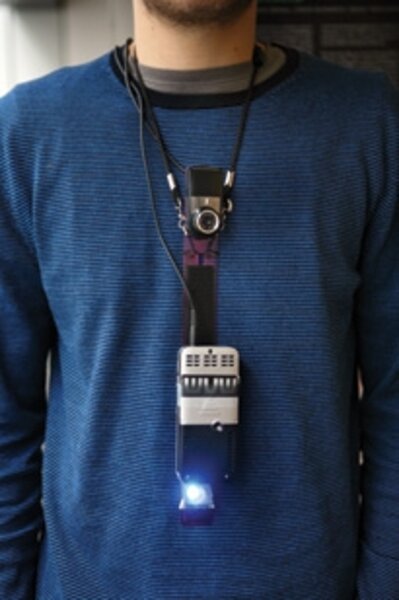Sixth Sense: A Web you can wear
Loading...
| Cambridge, Mass.
For all its celebrated omnipresence, the World Wide Web can seem like a closed world unto itself. It’s more portable now, to be sure. But those who visit it still must stare at glowing screens and tune out everything else around them.
To Pranav Mistry, this all feels highly inconvenient. The postdoctoral student at the Massachusetts Institute of Technology wants online life to converge with real life, be it during a conversation at a party or a commute on the interstate. His latest project, a “wearable computer” dubbed Sixth Sense, lays out a path toward realizing this “immersive” vision of the Net.
“We like the physical world,” Mr. Mistry says, emphasizing the verb as though speaking on behalf of BlackBerry and iPhone addicts everywhere. “We want to merge the dynamism of the digital world with the objects we’re used to.”
At first glance, Sixth Sense seems disarmingly simple: a Web cam, projector, and battery pack hang around Mistry’s neck on a lanyard. The components, which together cost about $350, plug into an Internet-enabled mobile phone that rests in the wearer’s pocket.
As the device’s name suggests, this straightforward design aims at a rather lofty goal: to make accessing the Internet seamless in ordinary life. People take in sights and smells without a conscious series of instructions. So why should we reach into our pockets to look up information online?
If that’s tough to fathom, consider one of the features already built into the device. Say the wearer goes to the grocery store and picks up a box of cereal from the shelf. The camera sees this action and identifies the product. An Internet search automatically finds its exact specifications, such as the brand or nutrition facts. Then, the projector beams a green or red light onto the item, letting the wearer know if the cereal meets user-defined criteria. A consumer, for instance, might only want to buy a brand that is American-made, packaged in recyclable materials, or high in fiber.
When outside conditions aren’t enough to prompt the Internet search, Sixth Sense makes use of gestures. Tracing a circle on your wrist tells the device to project a digital clock on your arm – the world’s lightest wristwatch, a fan joked. And the most natural function of all might be the way the camera snaps a picture when the wearer frames something with his fingers.
In this early stage, Mistry wraps colored tape around his thumbs and pointer fingers, markers that make them easier for the Web cam to spot.
So far, there are just a handful of online databases that Sixth Sense can fluidly mine for pieces of what Mistry’s MIT adviser, Pattie Maes, calls “instant wisdom.” In addition to grocery store inventories, Mistry has programmed the computer to display book reviews from Amazon.com onto the books themselves, and project video clips about current events onto newspapers.
As slick and automatic as these capabilities might appear, they do not yet offer a significant upgrade over an Internet-enabled cellphone.
But observers are already envisioning future improvements to Sixth Sense that could result in some startling possibilities.
“Its current representation is a pretty fun parlor trick that has the roots of being a transformative capability down the road,” says Jonas Lamis, founder of the advanced technology research and consulting firm SciVestor in Austin, Texas.
Among Mr. Lamis’s predictions: Sixth Sense’s current projector will eventually give way to contact lenses that overlay data directly onto a person’s field of vision.
In places where we now find fixed advertisements, like posters or billboards, we will see ads calibrated to our exact location and interests, he says. We will effortlessly access virtual conversations, like those on Twitter, about the people, places, and events we come across in person.
And Sixth Sense-type computers with advanced facial recognition capabilities, Lamis says, might show information about the people we pass on the street. We would know if he donated to a political candidate, if she writes an environmentally themed blog, or if he appears in a database of registered child predators – all in real time.
“People in different areas are thinking about this as viable for consumers down the road,” Lamis says. “It [will have] really profound implications for how [we] ultimately see the world.”
Of course, those applications are a long way off. As Lamis points out, they will depend on improvements to related technologies, such as strength of wireless networks and size of computer chips.
They will also have to wait for a Sixth Sense business model. The MIT researchers have a patent on the way, but they are unsure what form their current prototype will take when it first hits store shelves. Mistry says it may eventually develop into a streamlined, all-in-one device.
The university has tinkered with several iterations of wearable computers over the years. Mistry’s model won’t be the last. But it has captured public interest like none of its predecessors.
Mistry and Ms. Maes presented Sixth Sense at the prestigious Technology, Design and Environment conference in February. Mistry now receives hundreds of e-mails each day about the technology – from artists who want to change the way they draw to hospital staff who want seamless access to patients’ vital signs.
Sixth Sense has also attracted attention from those working on more literal sixth senses.
Todd Huffman runs an Internet company in Phoenix that has developed a system of using GPS data from cellphones to automatically group photos by location. In 2004, Mr. Huffman had a magnet surgically inserted into his fingertip to study the utility of cochlear implants for the hearing-impaired.
The difference between a magnetic implant and an instrument that detects currents – the same distinction between a Sixth Sense experience and pulling out a smart phone – is an important one, Huffman says.
He describes how the magnet in his hand gives him an intuitive understanding of where large, out-of-sight electrical objects are near him, the result of feeling currents without intentionally seeking them. The more effortless an observation, Huffman believes, the more people can productively tailor their behavior to that information. “Right now, we’re just getting to the phase where people appreciate how an “immersive” digital environment can be as complex and rich as sensation,” he says. “It seems like a weird thing to most people.”
Such an environment, with its more relentless ubiquity of information, may also pose new challenges. We may become increasingly dependent on Sixth Sense-type devices, some worry, and others question whether people will become distracted or even anxious as a result of mass quantities of this instant wisdom. Privacy concerns may also come to the fore as our digital personas become part of our in-person ones.
But the Sixth Sense team, along with its growing fan club, remains quite excited about the future.
“You could almost argue that the online world is more exciting than the real world,” Maes says.
Soon, they hope, they will be one and the same.






